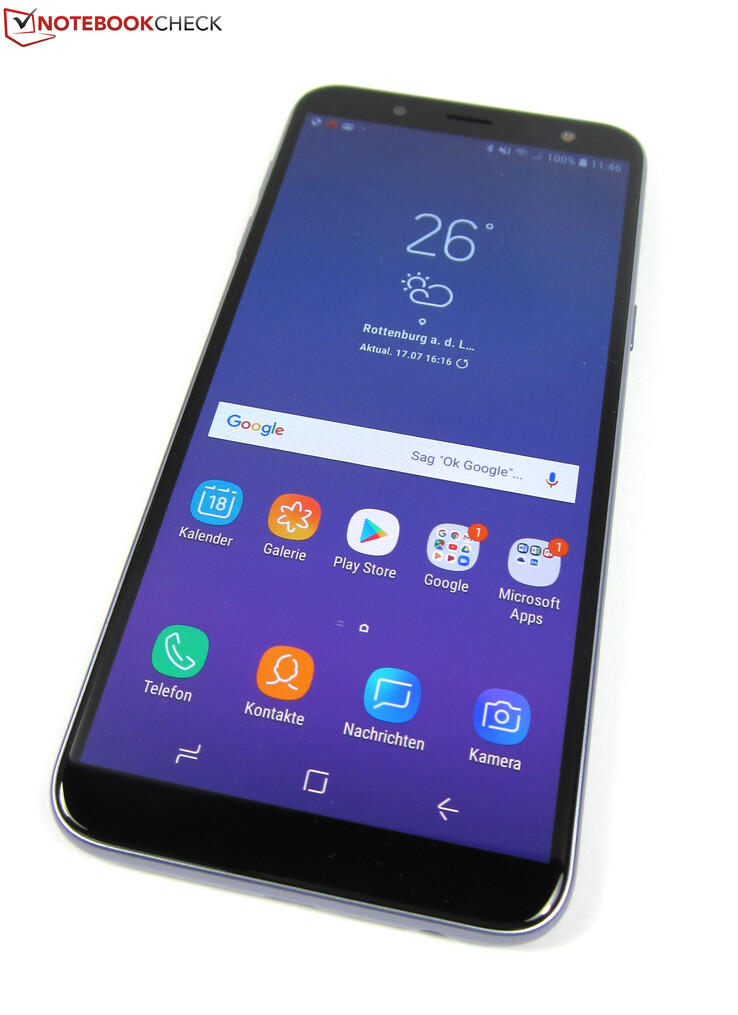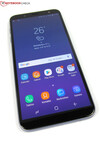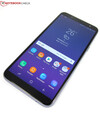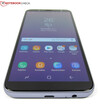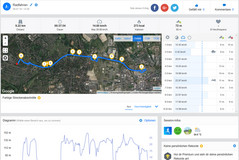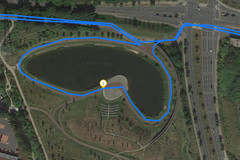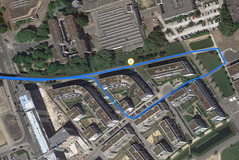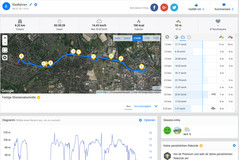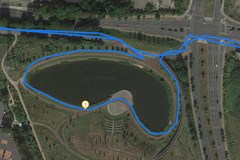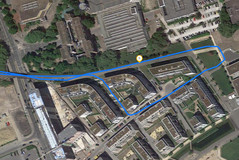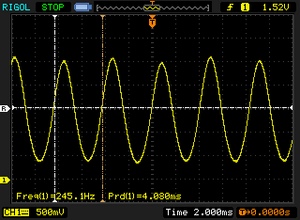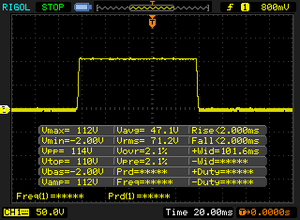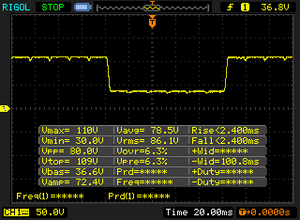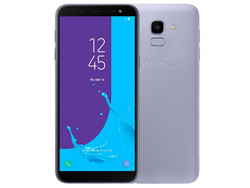Test: Samsung Galaxy J6 (2018) Smartphone (Sammanfattning)
Topp 10...
» Topp 10: Bästa bärbara allround/multimediadatorerna
» Topp 10: Bästa bärbara speldatorerna
» Topp 10: Bärbara budget/kontorsdatorer
» Topp 10: Bästa bärbara kontors/premiumdatorerna
» Topp 10: Bärbara arbetsstationer
» Topp 10: De bästa små/kompakta bärbara datorerna
» Topp 10: Bästa ultrabooks
» Topp 10: Bästa hybriddatorerna
» Topp 10: Bästa surfplattorna
» Topp 10: Marknadens bästa smartphones
Storleksjämförelse
| |||||||||||||||||||||||||
Distribution av ljusstyrkan: 93 %
Mitt på batteriet: 296 cd/m²
Kontrast: ∞:1 (Svärta: 0 cd/m²)
ΔE ColorChecker Calman: 2.8 | ∀{0.5-29.43 Ø4.78}
ΔE Greyscale Calman: 1.9 | ∀{0.09-98 Ø5}
96.3% sRGB (Calman 2D)
Gamma: 2.09
CCT: 6398 K
| Samsung Galaxy J6 2018 Super AMOLED, 1480x720, 5.6" | Asus ZenFone 4 Selfie Pro ZD552KL AMOLED, 1920x1080, 5.5" | Motorola Moto G6 Plus IPS, 2160x1080, 5.9" | Samsung Galaxy J5 (2017) Duos Super AMOLED, 1280x720, 5.2" | Sony Xperia XA2 IPS, 1920x1080, 5.2" | Huawei Honor 7X IPS, 2160x1080, 5.9" | Nokia 6 2018 IPS, 1920x1080, 5.5" | |
|---|---|---|---|---|---|---|---|
| Screen | -46% | 61% | 20% | -44% | 14% | -55% | |
| Brightness middle (cd/m²) | 296 | 456 54% | 761 157% | 448 51% | 513 73% | 533.2 80% | 417 41% |
| Brightness (cd/m²) | 294 | 455 55% | 723 146% | 451 53% | 506 72% | 511 74% | 421 43% |
| Brightness Distribution (%) | 93 | 85 -9% | 90 -3% | 91 -2% | 93 0% | 88 -5% | 88 -5% |
| Black Level * (cd/m²) | 0.69 | 0.42 | 0.35 | 0.61 | |||
| Colorchecker dE 2000 * | 2.8 | 5.6 -100% | 2.4 14% | 2.7 4% | 5 -79% | 2.83 -1% | 6.1 -118% |
| Colorchecker dE 2000 max. * | 9.8 | 11.1 -13% | 5.2 47% | 9.8 -0% | 11.4 -16% | 6.72 31% | 11.2 -14% |
| Greyscale dE 2000 * | 1.9 | 6.9 -263% | 1.8 5% | 1.6 16% | 7.8 -311% | 3.7 -95% | 7.1 -274% |
| Gamma | 2.09 105% | 2.3 96% | 2.21 100% | 2.06 107% | 2.2 100% | 1.9 116% | 2.16 102% |
| CCT | 6398 102% | 7883 82% | 6312 103% | 6557 99% | 7964 82% | 6918 94% | 8362 78% |
| Contrast (:1) | 1103 | 1221 | 1523 | 684 |
* ... mindre är bättre
Skärmflimmer / PWM (Puls-Width Modulation)
| Skärmflimmer / PWM upptäckt | 245.1 Hz | ||
Displayens bakgrundsbelysning flimrar vid 245.1 Hz (i värsta fall, t.ex. med PWM) . Frekvensen för 245.1 Hz är relativt låg, så känsliga användare kommer sannolikt att märka flimmer och uppleva ansträngda ögon vid den angivna ljusstyrkeinställningen och nedan. Som jämförelse: 53 % av alla testade enheter använder inte PWM för att dämpa skärmen. Om PWM upptäcktes mättes ett medelvärde av 8111 (minst: 5 - maximum: 343500) Hz. | |||
Visa svarstider
| ↔ Svarstid svart till vitt | ||
|---|---|---|
| 4 ms ... stiga ↗ och falla ↘ kombinerat | ↗ 2 ms stiga | |
| ↘ 2 ms hösten | ||
| Skärmen visar väldigt snabba svarsfrekvenser i våra tester och borde vara mycket väl lämpad för fartfyllt spel. I jämförelse sträcker sig alla testade enheter från 0.1 (minst) till 240 (maximalt) ms. » 15 % av alla enheter är bättre. Det betyder att den uppmätta svarstiden är bättre än genomsnittet av alla testade enheter (20.2 ms). | ||
| ↔ Svarstid 50 % grått till 80 % grått | ||
| 4.8 ms ... stiga ↗ och falla ↘ kombinerat | ↗ 2.4 ms stiga | |
| ↘ 2.4 ms hösten | ||
| Skärmen visar väldigt snabba svarsfrekvenser i våra tester och borde vara mycket väl lämpad för fartfyllt spel. I jämförelse sträcker sig alla testade enheter från 0.165 (minst) till 636 (maximalt) ms. » 15 % av alla enheter är bättre. Det betyder att den uppmätta svarstiden är bättre än genomsnittet av alla testade enheter (31.6 ms). | ||
| JetStream 1.1 - Total Score | |
| Huawei Honor 7X (Chrome 63.0.3239.111) | |
| Nokia 6 2018 (Browser: Chrome 65) | |
| Motorola Moto G6 Plus (Chrome 66) | |
| Asus ZenFone 4 Selfie Pro ZD552KL (Chrome 64) | |
| Sony Xperia XA2 (Chrome 65.0.3325.109) | |
| Samsung Galaxy J5 (2017) Duos (Samsung Browser 5.4) | |
| Genomsnitt Samsung Exynos 7870 Octa (20.8 - 26.4, n=8) | |
| Samsung Galaxy J6 2018 (Chrome 67.0.3396.87) | |
| Octane V2 - Total Score | |
| Genomsnitt av klass Smartphone (2228 - 121337, n=199, senaste 2 åren) | |
| Huawei Honor 7X (Chrome 63.0.3239.111) | |
| Motorola Moto G6 Plus (Chrome 66) | |
| Nokia 6 2018 (Browser: Chrome 65) | |
| Samsung Galaxy J5 (2017) Duos (Samsung Browser 5.4) | |
| Asus ZenFone 4 Selfie Pro ZD552KL (Chrome 64) | |
| Sony Xperia XA2 (Chrome 65.0.3325.109) | |
| Genomsnitt Samsung Exynos 7870 Octa (3721 - 4968, n=8) | |
| Samsung Galaxy J6 2018 (Chrome 67.0.3396.87) | |
| Mozilla Kraken 1.1 - Total | |
| Samsung Galaxy J6 2018 (Chrome 67.0.3396.87) | |
| Sony Xperia XA2 (Chrome 65.0.3325.109) | |
| Nokia 6 2018 (Browser: Chrome 65) | |
| Motorola Moto G6 Plus (Chrome 66) | |
| Asus ZenFone 4 Selfie Pro ZD552KL (Chrome 64) | |
| Genomsnitt Samsung Exynos 7870 Octa (6784 - 11916, n=8) | |
| Huawei Honor 7X (Chrome 63.0.3239.111) | |
| Samsung Galaxy J5 (2017) Duos (Samsung Browser 5.4) | |
| Genomsnitt av klass Smartphone (257 - 28190, n=154, senaste 2 åren) | |
| WebXPRT 2015 - Overall | |
| Nokia 6 2018 | |
| Huawei Honor 7X (Chrome 63.0.3239.111) | |
| Motorola Moto G6 Plus (Chrome 66) | |
| Sony Xperia XA2 (Chrome 65.0.3325.109) | |
| Samsung Galaxy J6 2018 (Chrome 67.0.3396.87) | |
| Samsung Galaxy J5 (2017) Duos (Samsung Browser 5.4) | |
| Genomsnitt Samsung Exynos 7870 Octa (64 - 91, n=8) | |
* ... mindre är bättre
| Samsung Galaxy J6 2018 | Asus ZenFone 4 Selfie Pro ZD552KL | Motorola Moto G6 Plus | Samsung Galaxy J5 (2017) Duos | Sony Xperia XA2 | Huawei Honor 7X | Nokia 6 2018 | Genomsnitt 32 GB eMMC Flash | Genomsnitt av klass Smartphone | |
|---|---|---|---|---|---|---|---|---|---|
| AndroBench 3-5 | 19% | 112% | -21% | 22% | 38% | 19% | 21% | 1568% | |
| Sequential Read 256KB (MB/s) | 206.5 | 269.3 30% | 286.6 39% | 204.4 -1% | 271.5 31% | 265.3 28% | 272.6 32% | 242 ? 17% | 2213 ? 972% |
| Sequential Write 256KB (MB/s) | 100.5 | 139.5 39% | 216.1 115% | 52 -48% | 127.4 27% | 127.9 27% | 118.3 18% | 100.5 ? 0% | 1831 ? 1722% |
| Random Read 4KB (MB/s) | 27.05 | 36.8 36% | 58.4 116% | 24.07 -11% | 43.07 59% | 81.4 201% | 38.78 43% | 43.1 ? 59% | 294 ? 987% |
| Random Write 4KB (MB/s) | 12.37 | 12 -3% | 62.8 408% | 9.9 -20% | 13.82 12% | 20.24 64% | 15.3 24% | 22.3 ? 80% | 333 ? 2592% |
| Sequential Read 256KB SDCard (MB/s) | 81.8 ? | 83.9 ? 3% | 83.7 ? 2% | 72.2 ? -12% | 86 ? 5% | 52.7 -36% | 83.4 ? 2% | 71.8 ? -12% | |
| Sequential Write 256KB SDCard (MB/s) | 65.8 ? | 72.1 ? 10% | 62.1 ? -6% | 44.21 ? -33% | 64.8 ? -2% | 30.55 -54% | 61.3 ? -7% | 52.9 ? -20% |
| PUBG Mobile | |||
| Inställningar | Värde | ||
| Balanced | 10 fps | ||
| Dead Trigger 2 | |||
| Inställningar | Värde | ||
| high | 60 fps | ||
(+) Den maximala temperaturen på ovansidan är 32.9 °C / 91 F, jämfört med genomsnittet av 35.2 °C / 95 F , allt från 21.9 till 247 °C för klassen Smartphone.
(+) Botten värms upp till maximalt 34.8 °C / 95 F, jämfört med genomsnittet av 34 °C / 93 F
(+) Vid tomgångsbruk är medeltemperaturen för ovansidan 25.9 °C / 79 F, jämfört med enhetsgenomsnittet på 32.9 °C / ### class_avg_f### F.
Samsung Galaxy J6 2018 ljudanalys
(+) | högtalare kan spela relativt högt (83.9 dB)
Bas 100 - 315 Hz
(-) | nästan ingen bas - i genomsnitt 24.6% lägre än medianen
(±) | linjäriteten för basen är genomsnittlig (10% delta till föregående frekvens)
Mellan 400 - 2000 Hz
(+) | balanserad mellan - endast 4.1% från medianen
(+) | mids är linjära (6.6% delta till föregående frekvens)
Högsta 2 - 16 kHz
(±) | högre toppar - i genomsnitt 5.6% högre än medianen
(±) | linjäriteten för toppar är genomsnittlig (7.2% delta till föregående frekvens)
Totalt 100 - 16 000 Hz
(±) | linjäriteten för det totala ljudet är genomsnittlig (21.2% skillnad mot median)
Jämfört med samma klass
» 40% av alla testade enheter i den här klassen var bättre, 8% liknande, 52% sämre
» Den bästa hade ett delta på 11%, genomsnittet var 35%, sämst var 134%
Jämfört med alla testade enheter
» 58% av alla testade enheter var bättre, 7% liknande, 35% sämre
» Den bästa hade ett delta på 4%, genomsnittet var 24%, sämst var 134%
Samsung Galaxy J5 (2017) Duos ljudanalys
(+) | högtalare kan spela relativt högt (86.8 dB)
Bas 100 - 315 Hz
(-) | nästan ingen bas - i genomsnitt 24.1% lägre än medianen
(±) | linjäriteten för basen är genomsnittlig (10.1% delta till föregående frekvens)
Mellan 400 - 2000 Hz
(+) | balanserad mellan - endast 2.4% från medianen
(+) | mids är linjära (4.6% delta till föregående frekvens)
Högsta 2 - 16 kHz
(±) | högre toppar - i genomsnitt 6.2% högre än medianen
(+) | toppar är linjära (4.7% delta till föregående frekvens)
Totalt 100 - 16 000 Hz
(±) | linjäriteten för det totala ljudet är genomsnittlig (18.8% skillnad mot median)
Jämfört med samma klass
» 22% av alla testade enheter i den här klassen var bättre, 10% liknande, 68% sämre
» Den bästa hade ett delta på 11%, genomsnittet var 35%, sämst var 134%
Jämfört med alla testade enheter
» 42% av alla testade enheter var bättre, 8% liknande, 50% sämre
» Den bästa hade ett delta på 4%, genomsnittet var 24%, sämst var 134%
Motorola Moto G6 Plus ljudanalys
(+) | högtalare kan spela relativt högt (86.3 dB)
Bas 100 - 315 Hz
(-) | nästan ingen bas - i genomsnitt 26.3% lägre än medianen
(±) | linjäriteten för basen är genomsnittlig (7.9% delta till föregående frekvens)
Mellan 400 - 2000 Hz
(+) | balanserad mellan - endast 3.9% från medianen
(+) | mids är linjära (5.4% delta till föregående frekvens)
Högsta 2 - 16 kHz
(+) | balanserade toppar - endast 4.6% från medianen
(+) | toppar är linjära (5.1% delta till föregående frekvens)
Totalt 100 - 16 000 Hz
(±) | linjäriteten för det totala ljudet är genomsnittlig (18.7% skillnad mot median)
Jämfört med samma klass
» 21% av alla testade enheter i den här klassen var bättre, 9% liknande, 70% sämre
» Den bästa hade ett delta på 11%, genomsnittet var 35%, sämst var 134%
Jämfört med alla testade enheter
» 42% av alla testade enheter var bättre, 8% liknande, 51% sämre
» Den bästa hade ett delta på 4%, genomsnittet var 24%, sämst var 134%
| Av/Standby | |
| Låg belastning | |
| Hög belastning |
|
Förklaring:
min: | |
| Samsung Galaxy J6 2018 3000 mAh | Asus ZenFone 4 Selfie Pro ZD552KL 3000 mAh | Motorola Moto G6 Plus 3200 mAh | Samsung Galaxy J5 (2017) Duos 3000 mAh | Sony Xperia XA2 3300 mAh | Huawei Honor 7X 3340 mAh | Nokia 6 2018 3000 mAh | Genomsnitt Samsung Exynos 7870 Octa | Genomsnitt av klass Smartphone | |
|---|---|---|---|---|---|---|---|---|---|
| Power Consumption | 30% | 9% | 39% | 17% | -28% | 9% | 3% | -31% | |
| Idle Minimum * (Watt) | 0.85 | 0.58 32% | 0.5 41% | 0.52 39% | 0.39 54% | 1.02 -20% | 0.67 21% | 0.71 ? 16% | 0.848 ? -0% |
| Idle Average * (Watt) | 1.51 | 1.31 13% | 1.78 -18% | 1.17 23% | 1.61 -7% | 2.46 -63% | 1.76 -17% | 1.909 ? -26% | 1.434 ? 5% |
| Idle Maximum * (Watt) | 1.57 | 1.33 15% | 1.81 -15% | 1.24 21% | 1.62 -3% | 2.51 -60% | 1.78 -13% | 1.995 ? -27% | 1.618 ? -3% |
| Load Average * (Watt) | 4.21 | 1.88 55% | 3.3 22% | 1.66 61% | 3.12 26% | 4.16 1% | 2.82 33% | 3.02 ? 28% | 7.01 ? -67% |
| Load Maximum * (Watt) | 5.88 | 3.8 35% | 5.14 13% | 2.94 50% | 4.92 16% | 5.87 -0% | 4.56 22% | 4.42 ? 25% | 11.3 ? -92% |
* ... mindre är bättre
| Samsung Galaxy J6 2018 3000 mAh | Asus ZenFone 4 Selfie Pro ZD552KL 3000 mAh | Motorola Moto G6 Plus 3200 mAh | Samsung Galaxy J5 (2017) Duos 3000 mAh | Sony Xperia XA2 3300 mAh | Huawei Honor 7X 3340 mAh | Nokia 6 2018 3000 mAh | |
|---|---|---|---|---|---|---|---|
| Batteridrifttid | -8% | 5% | 16% | 20% | -22% | 14% | |
| Reader / Idle (h) | 24.9 | 30.8 24% | 26.1 5% | 41.7 67% | 18.5 -26% | 30.6 23% | |
| H.264 (h) | 14.5 | 9 -38% | 15.3 6% | 12.8 -12% | 11.3 -22% | ||
| WiFi v1.3 (h) | 11.8 | 10.9 -8% | 11.7 -1% | 12.3 4% | 14.8 25% | 11.1 -6% | 15.7 33% |
| Load (h) | 5 | 6.7 34% | 7.5 50% | 5 0% | 3.3 -34% | 6 20% |
För
Emot
Läs den fullständiga versionen av den här recensionen på engelska här.
Samsung Galaxy J6 (2018) är en bra instegs-telefon som har en del brister på viktiga områden. Samsung förlitar sig så mycket på Galaxy J-seriens tyngd att vi rekommenderar förra årets Galaxy J5 (2017) framför J6 (2018)
Samsung Galaxy J6 (2018) är en bra instegs-smartphone, men spring inte ut och köp den direkt; förra årets Galaxy J5 (2017) har fler funktioner till halva kostnaden.
På många områden har J6 (2018) fler brister än sin föregångare. Även om höljet är välgjort är det gjort i plast istället för aluminium, vilket Samsung använde för J5 (2017). Dessutom har Samsung i generationsskiftet tagit bort möjligheten att ansluta till 5 GHz WiFi och dumpat automatisk ljusstyrka. Vidare använder den samma kamerasensorer som J5 (2016). Alla dessa felsteg begränsar hur användbar J6 (2018) är i vardagen jämfört med sin föregångare.
Dessa problem gör andra beslut som valet av SoC, avsaknaden av USB Typ C, bristen på snabbladdning och 720p-skärmen än mer frustrerande när man betänker vad konkurrenterna erbjuder för tillfället.
J6 (2018) gör dock en del saker tillräckligt bra. Enheten har en dedikerad microSD-plats och dubbla nano SIM-platser samt ett överflöd av LTE-täckning; betydligt mer än J5 (2017). J6 (2018) kommer även med Android Oreo 8.0 och har en exakt GPS-modul. Slutligen har enheten bra batteritid och dess Super AMOLED-skärm är både ljusstark och har exakta färger.
Samsung Galaxy J6 2018
- 07/20/2018 v6 (old)
Manuel Masiero




